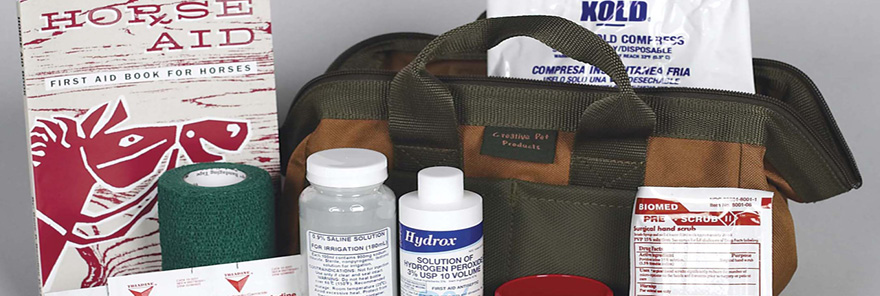Horse owners are traditionally the most DIY of animal-lovers.
Hands up if your vet has ever looked at you and said “You know how to take stitches out, right?” or if you see them more for a scheduled drop-off of prescription medicines than for emergencies.
But even if you prefer to let the professionals take care of the messy business of treating wounds and checking vitals, there are certain first aid must-haves that no stable can be without. Unless you have a veterinarian on staff, at some point you will find yourself with an emergency that requires immediate care — and a vet out on the road with an indefinite arrival time. Having basic first aid skills, and the tools to use them, are part of horse ownership.
Buying a ready-made first aid kit is one easy option to help you feel prepared for any emergency. Most equine supply stores offer pre-made first aid set-ups: SmartPak’s options range from the $14.95 “mini” first aid kit (featuring wound-care items like gauze pads, iodine swabs, and antibiotic packets) to the massive $685 “Large First Aid Station,” which is basically a medical tack room in a box.
Of course, when buying a pre-made first aid kit, you run the risk of duplicating items or over-paying for things you already have. The Large First Aid Station includes many items most horse-owners would consider normal parts of their inventory, including insect repellent and Nitrofurazone. If you want to assemble your own first aid essentials, here are the very, very basics:
Povidone 10% Iodine: Most of us know it as Betadine, the surgical rinse and scrub that turns our hands orange. Povidone solution is an all-purpose, non-stinging disinfectant for just about every abrasion and scrape your horse can manage to inflict upon himself.
Rubbing Alcohol: Another disinfectant, use this one for any instruments you might need in order to clean up or secure a wound.
Self-adhesive bandages: Stretchy, self-stick wraps like Co-Flex and Vetrap are invaluable for holding emergency bandages or ice packs in place. Use caution at points where joints flex; pressure from these wraps can cut into skin.
Antiseptic cream: Whether it’s triple antibiotic from the drug store or an equine-only topical, once you’ve disinfected a wound, you’ll want an antiseptic cream to keep it that way.
Wound powder: Some wounds don’t want to stop bleeding. Powders stop the bleeding and help prevent proud flesh.
Thermometer: The old-fashioned glass kind, with a piece of string tied to the end, is an essential for any barn. Knowing your horse’s base temperature, and how far he has strayed from it, gives you an excellent picture of just how unwell your horse is feeling. And the veterinarian will appreciate the advance information.
Petroleum Jelly: It’s for the thermometer. You can also coat minor abrasions with the goo to keep it moist and encourage hair to grow back without a scar.
Scissors: For cutting bandages, duct tape, or anything else that’s in your way.
Saline solution: Horses with puffy or swollen-shut eyes might have something as minor as an eyelash or a piece of hay in there, but you need saline to rinse it away before irritation sets in, possibly causing an ulcer.
This is the most basic of lists, for taking care of minor issues or simply tiding the horse over until the veterinarian arrives. Many horse owners would add dozens of items to this list, including prescription medications: Banamine, phenylbutazone, acepromazine, and antibiotics, to name just a few medicine-cabinet regulars.
As a horse owner, it’s up to you to discuss your comfort level with medical procedures with your own veterinarian, and decide how much you need to know and be prepared for. But however squeamish you might feel, be prepared for some level of medical intervention in your horse’s life. So stock the medicine cabinet now — it will save you a lot of worry later!


